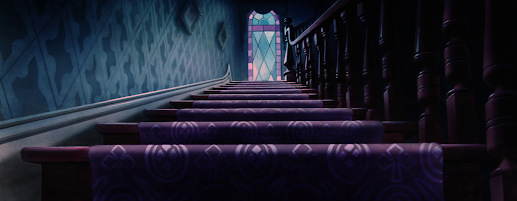As you can see above, the Film is in the Cinemascope Aspect Ratio, my preferred Widescreen Lenses.
Most 2D Animated films don't touch CINEMASCOPE Lenses for a multitude of Reasons:
As exemplified by the image above of the ICONIC Spaghetti Scene, the lenses are wide so that creates risks of not filling in that Negative space, especially when Screen Direction is important for the presentation.
And judging by the research I've read on the various Interwebs, Wikis, and DVD/Blu-Ray Featurettes, The animators and photographers admitted they weren't ready for Widescreen yet..... or ever would be, but they had no choice but to embrace the change of Camera Lenses and Filmstock.
One example that boggled our animators back in the mid-50s was the fact that because of a dramatic increase of the size of the canvas, various practices that the animators were used to using just don't apply to the new lenses.
For example, in the 4:3 original aspect ratio from Peter Pan and prior films, the backgrounds could move behind the characters.
One example of a moving background was the famous HEIGH-HO Number from Snow White.
But because of how sparse the setting is when moving to Cinemascope, the animators can no longer move the background as much as they used to without using a larger canvas for backgrounds.
So the animators had to learn to animate their characters as if they are the ones moving them around.
This resulted in creating nice scenes such as this below
What was lost was the Animator's Preference of Close Ups.
Back in the day, the closeups could be easily achieved and fill the entire 35MM lenses.
But not with Cinemascope.
If those closeups of the face did happen, then it makes it impossible to fill the entire screen due to the width of the lenses and the artwork.
No wonder Animation preferred the Anamorphic 1.85:1 Lenses when Widescreen finally caught on with the studios in the 60s.
Though that did not stop animators from doing shots like this scene with Trusty sleeping.
So a new method of filling the screen happened which was to fill the Foreground with more Characters.
Such as this scene with Trusty meeting Lady and Tramp’s puppies.
It's a simple and dirty hack but it does work as it prevents the attention span from shifting away from the characters to the backgrounds.Something that would later be a thing of a fierce camera battle once again with SLEEPING BEAUTY 4 years later in 1959.
Why did LADY & THE TRAMP switch to CINEMASCOPE?
Because according to sources, Disney wanted to represent sort of a DOG's View of what their environment looks like, without the Yellow/Blue Colorblindness of Dog Eyes in real life.
Until the advency of home video, Surround Sound on Lady and the Tramp was out of the question since unlike with SLEEPING BEAUTY, LADY wasn't planned to have stereophonic sound so I bet those who were alive in 1955 who saw this film in Cinemascope probably would have wished DISNEY gave this film a full FOUR-TRACK or SIX TRACK stereophonic Soundtrack because with just widescreen, monaural soundtracks would not make the film immersive enough.
Though Surround sound on a film that was originally released with a monaural soundtrack can still be a sore point for those who want restorations to be true to the original release.
As for the release of this film, I heard that to compensate for theaters that were not equipped or built for Cinemascope, or any form of widescreen,
The animators had to re-photograph the film using modified versions of their Exposure Sheets used for the film that's optimized for 4:3.
But unfortunately for VHS lovers, myself included back in 1999, we were stuck with Pan-and-Scan versions of the cinemascope print so for those who watched the film on VHS since the 1980s, we had to contend with the fact that it's actually the Cinemascope print that's using Pan-and-Scan which meant the camera faked movement.
Fortunately for those who watch on DVD, Blu-Ray, Ultra-HD Blu-Ray, and 4K Streaming, the film always uses it's original CINEMASCOPE Presentation to maintain all that widescreen goodness.
Though most Streaming Services for Windows, Mac, or Linux, are not optimized for ultrawide so If you plan to watch movies like this on your Ultra-Wide Monitor like my ASUS TUF Ultrawide, just burn the Blu-Ray into your SSD using VLC Player or MakeMKV, reformat it for Ultrawide, and there you go.
Or just look through the Catacombs of Archive.org for a 4K Print of the film that's already optimized for Ultrawide because watching Cinemascope movies on an Ultrawide monitor natively just looks good compared to watching on a TV or a Cinema Screen that's optimized for 16x9.
Or if you still want to watch it on your browser, download the Ultrawide Extension for CHROME.
Though watching on an Ultrawide monitor can't beat the superiority of watching on a Cinema Screen that's optimized for 21x9 that's for sure.














No comments:
Post a Comment